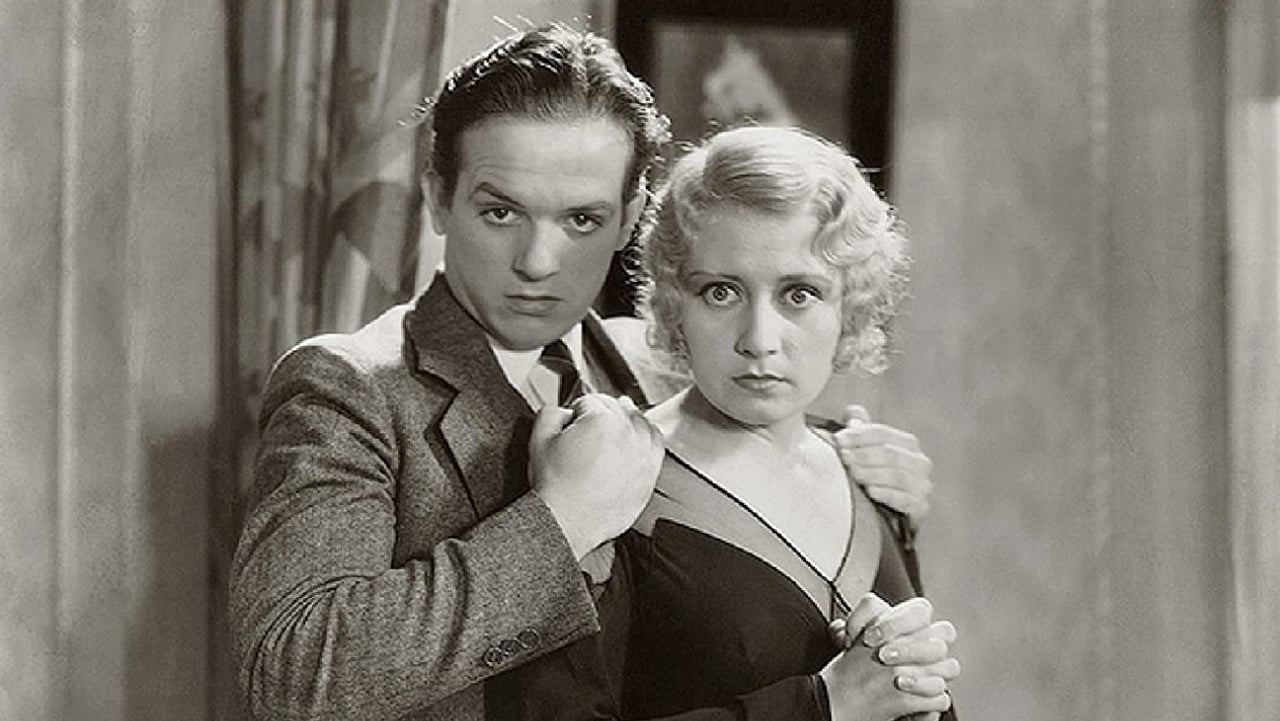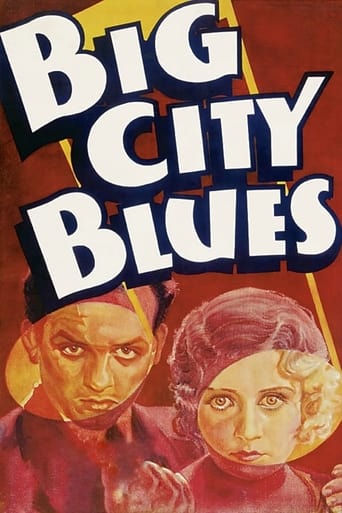

SERIOUSLY. This is what the crap Hollywood still puts out?
... View MoreA lot of fun.
... View MoreThe acting in this movie is really good.
... View MoreOne of the worst ways to make a cult movie is to set out to make a cult movie.
... View MoreBIG CITY BLUES (Warner Brothers, 1932), directed by Mervyn LeRoy, is a Depression era melodrama without the focus on the unemployed in breadlines or the homeless struggling to survive, but a cliché story about the survival of a country boy who ventures to the big city, the "Big Apple," better known as New York. Starring Joan Blondell, her role is actually secondary but crucial to the plot, while the Eric Linden, whose name comes below hers, is the central focus.The story revolves around Buddy Reeves (Eric Linden), a naive country boy from Hoopersville, Indiana. After inheriting $1100, he decides to fulfill his dream by coming to live in the greatest city in the world, New York. Unable to take his dog, Duke, with him, Buddy offers the pooch to a Willow Junction station master (Grant Mitchell), who accepts the animal only as a loan, knowing full well, that he will do exactly what he did as a youth, by venturing to the big city only to return home disillusioned. However, Buddy believes different, especially since he only has a one way ticket. Upon his arrival at Grand Central Station, Buddy, as he carries his suitcases, strolls down with amazement the busy streets surrounded by the "rush, tension and crowds." He registers at the Hotel Hercules, room 3663, where his Cousin Gibbony (Walter Catlett) enters the scene to teach him the ropes in becoming a true New Yorker as well as fast-talking his way in acquiring some of his money. Gibbony, a comedic con-artist who claims to know the most important people in town, ranging from Mayor Jimmy Walker to actress Constance Bennett, arranges for the young lad to be introduced to a handful of his friends by having an all night party to take place in Buddy's hotel room. That evening, Buddy becomes infatuated with an attractive show girl named Vida Fleet (Joan Blondell). During this very active party, which consists of radio background music to current hit tunes as "My baby Just Cares for Me," Lem Sully (Lyle Talbot), actor and drunk, along with globetrotter Shep Atkins (Humphrey Bogart) get into an argument over the drunken Jackie DeVoe (Josephine Dunn), a Follies girl. A physical fight ensues, leading to a whiskey bottle being thrown across the room, hitting the head of Jackie, causing her death. Suddenly the room is quiet. All the guests make a hasty departure, especially Vida, leaving Buddy to be faced with a possible murder charge. Breaking away as Hummell, the house detective (Guy Kibbee) enters to discover the body, Buddy hides amongst the crowded city, hoping to avoid being arrested by Quelkin (Thomas Jackson) of the homicide squad, who is hot on his trail.Others in the cast consist of Inez Courtney as Faun; Ned Sparks as Stackhouse; Jobyna Howland (in her Marjorie Rambeau-type performance) as Mrs. Cartlidge, the 55 Club speakeasy "madame", along with interesting assortment of notable actors assuming no screen credit, including Josephine Dunn (Al Jolson's co-star in 1928's THE SINGING FOOL); J. Carroll Naish as a bootlegger; Herman Bing as a German waiter; Clarence Muse as the black singing waiter vocalizing "Every Day Can Be a Sunday"; and the heard but not seen Dick Powell as the radio announcer advertising Yum Yum Popcorn.Eric Linden is ideally cast as naive but vulnerable young lad, along with Blondell in her usual street smart, tough but loyal girlfriend performance. They would be reunited once more in race-car drama, THE CROWD ROARS (1932) starring James Cagney. Of the supporting players, it is Walter Catlett sporting glasses, derby and cigar (a cross between comedians Groucho Marx and Robert Woolsey), the scene stealer who livens things up.With so much happening during its brisk and brief 65 minutes, BIG CITY BLUES moves as quickly as any speeding cars or pedestrians depicted on screen. Along with other then current New York sounding film titles, MANHATTAN PARADE (1931), CENTRAL PARK (1932), 42nd STREET (1933), just to name a few, no other movie studio like Warners captures the feel and essence of New York City life, and BIG CITY BLUES is no exception. Not as well known as the more famous New York movies of this period, it's worth catching whenever presented during the late night hours on Turner Classic Movies.(**1/2)
... View MorePerhaps to underscore the quick pace of life in New York, "Big City Blues" moves along at a hectic sixty three minute pace, and tries to cram as much action as it can into that amount of time. Willow Station railroad agent (Grant Mitchell) has been there and done that, and bets a ten spot with a buddy that anxious traveler Bud Reeves (Eric Linden) will be back within a month.For his part, Bud is flush with enthusiasm and eleven hundred dollars and ready to make his mark on the big town. He's met by fast talking cousin "Gibby" Gibboney (Walter Catlett), who has a knack for getting others to pay his way, and completely monopolizes the conversation in every scene he's in. He's on a first name basis with a few up and coming showgirls, particularly cute Vida Fleet (Joan Blondell), who immediately becomes fond of the rube from Hoopersville, Indiana. Things move a bit too fast though, as Gibby organizes a welcome party for Bud in his room at the Hotel Hercules, and all manner of show biz types begin to arrive, among them Shep Adkins (Humphrey Bogart). Shep is about to move in on Len Scully's (Lyle Talbot) girl, Lenny objects with his fists, and a brawl breaks out that leaves the young showgirl dead.Not knowing what to do, young Bud follows the example of everyone else at the party, he high tails it before the law can arrive. Night watchman Hummel (Guy Kibbee) revels in his five minutes of fame for finding the dead victim, while detective Quelkin (Thomas Jackson) tails Vida who he hopes can lead him to Bud Reeves, guilty until proved innocent. By accident, Hummel solves the case by going for his whiskey bottle in the hotel linen closet, where he finds Scully's body, a suicide victim with a shard of the broken bottle that neatly fits with the piece recovered by the police.Back at Willow Station, it only takes the railroad agent three days to collect on his bet, as Bud gratefully touches down on home turf. He still has visions of grandeur for life in New York, but has grown up enough to have some patience for it. Maybe next time, things will work out a bit better.By 1932, Humphrey Bogart had a handful of movie credits to his name, but nothing significant as of yet. That was about to change with his next film, "Three on a Match", which also co-starred Joan Blondell. Both would work together two more times, in 1936's "Bullets or Ballots" with Edward G. Robinson, and the 1937 comedy "Stand-In". All are recommended for fans of either, while "Bullets or Ballots" is a fine early example of the mobster genre made popular by films like "Public Enemy" and "White Heat".
... View MoreWARNING: SPOILERS AHEAD! This is a fun movie that gets better after the first viewing. I first watched it just for the early Bogart. When you watch it for the whole effect you'll probably wonder why it's never been on VHS or DVD. Well, there's this young man who's leaving the sticks for the Big Apple. The old men at the train station try to tell him he's in for disappointment, but he doesn't listen. In New York he gets an $8 room (nice for 1932) where his cousin takes advantage of him by using some of his $1,100 cash for parties and booze. He meets Joan Blondell and they are attracted to each other. It's funny how in this pre-code film, they never kiss once, even though adult themes are everywhere. Well, during the party in which almost everyone is drunk or stoned, Bogart tries to take another man's girlfriend home, which starts a brawl. A bottle is thrown, striking a girl in the head, killing her. Everybody runs off, leaving the poor kid from the sticks with the dead girl in his hotel room. As he avoids the police, he meets up with an older woman who would like him to spend some time with her. He finds Joan Blondell again, and loses the rest of his cash trying to win enough money so they can get away from it all. They get caught, taken down to the station, are grilled, and finally Bogart's brawling partner is found after hanging himself, with "proof" that the kid from the sticks is innocent. The two kids hug at the train station and they young man goes back to the sticks, only to decide to make some money to return to New York.
... View MoreBig City Blues is a marvelous reminder of the vibrancy of American cinema in the early sound days. Directed by the always reliable Mervyn LeRoy, the film features uncredited performances by a wonderful cast, including Humphrey Bogart, Lyle Talbot, Dennis O'Keefe, Dick Powell (hilarious as the voice of a radio ad-man expounding on the virtues of Yum Yum brand popcorn), and Clarence Muse (who delivers some terrific singing in a speakeasy scene), as well as Joan Blondell as the brassy showgirl with a heart of gold, Eric Linden as a smalltown rube, and especially Walter Catlett as Linden's Cousin Gibby, who's responsible for most of the trouble that takes place. Written by Lillie Hayward, the script is hilarious, intelligent, and insightful, especially when it pokes fun at the peccadilloes of big city life. Bogart has a particularly juicy line when, reading from a newspaper, he informs partygoers that the police have recently picked up a criminal with "a handgun in one pocket and a lipstick and powderpuff in the other"! The same party sequence also features the sight of a nervous young lady reading from the infamous (and much censored) lesbian novel "The Well of Loneliness" by Radclyffe Hall. In short, this is a fine example of pre-Code filmmaking and should be of interest to all fans of 30s cinema.
... View More